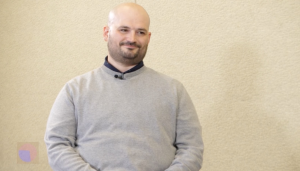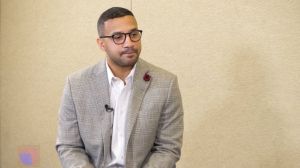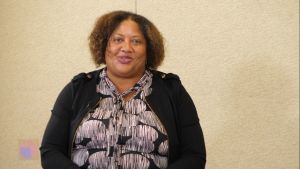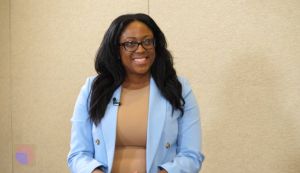During Fair360, formerly DiversityInc’s Top 50: Leadership Accountability event on Nov. 4, Fair360, formerly DiversityInc CEO Carolynn Johnson led a fireside chat with Keybank Chairman, CEO and President, Chris Gorman on the subject of talent readiness in the corporate world. Gorman, whose company ranked No. 35 on The Fair360, formerly DiversityInc Top 50 Companies for Diversity list in 2020, spoke about a number of key talent readiness principles including making sure you have an ample pool of internal candidates to promote from; figuring out the best methods for moving top employees around internally within an organization to guarantee maximum growth and profitability; and much, much more. Here’s a look back at their conversation.
Carolynn Johnson: Thank you for joining us here today, Chris. For those who don’t know, can you just briefly talk with us about how you describe talent readiness?
Chris Gorman: At Keybank, we’re in the people business, right? We’re a bank, so we’re not fortunate enough to have some unique operating software. We’re not fortunate enough to have some shiny object that everyone wants. So, when we think about talent readiness, it is core to our strategy. And specifically, when we think about building capabilities for the future, it’s important that we have a diverse, talented and well-equipped workforce with the skills and competencies to be successful — not only for today, but the future. That’s what talent readiness means to me.
Johnson: Has that definition changed for you over time?
Gorman: It definitely has. It’s changed a lot, in a number of ways. There was a point in time when we would typically just hire bankers, and banking was just an extension of credit. But now, as you all know, payments have also become a huge part of banking. Providing strategic advice is also a huge part of banking. Frankly, we hire as many engineers today as we do MBAs. When we think about talent readiness now, not only do we have to bring in the right people, not only do they have to be diverse, but we have to make sure that we develop the people we’re putting in these positions and include them. That’s how we stay in a position to constantly move our business forward. Our goal, just from a diversity perspective, is that we want our talent — we want our teammates — to reflect our 3.5 million customers. So that’s another aspect of talent readiness for us as well, and one that’s really important to us.
Johnson: How do diversity and inclusion efforts within KeyBank impact your talent readiness procedures?
Gorman: It basically impacts every part of what we do. When we do our talent planning, for example, we’re now doing succession planning all the way down in our organization. We always used to do a lot of succession planning at our top levels, but now it’s happening at every level. And that is really, really important when you think about talent planning around all parts of our business, and especially around diversity, right? Because we have to sometimes be thinking one and two moves ahead in terms of how we’re going to move people along. So now we’re having strategic discussions about our teammates and how we can advance them for really an early portion of their career.
Johnson: Does that carry over to your hiring practices as well?
Gorman: Definitely! We’re doing a lot of new measuring when it comes to hiring. For example, we make sure that any slate — we call any job search a slate — is now focused on diversity and inclusion. We’ve always required that at the senior level, but now we’re doing it at every level, because a lot of times those junior positions get filled really quickly since there are more people that can do them. So now, with each slate, it’s very, very important that we get a diverse group of candidates to select from. And when someone comes to me looking to fill a position, I can tell them “don’t just come to me with anyone, unless you’re ready to tell me who else you considered that was diverse and was on the slate, and why —for whatever reason — they weren’t the right person for the job.”
The other thing is that we’ve put in specific measures to help us in those efforts. We have internal job grades that wouldn’t mean anything to people outside the company — but a job grade 84 for example is sort of the lowest rung of senior management. And what we’ve said is, in the next five years, we’re going to expand people of color in job grade 84 and above by 25%. Over the next decade, we’re going to expand it by 50%. And this is eminently doable, by the way, so that’s another step we’re taking that I’m very proud of.
Another important change we’ve been making is looking at the actual language that goes into a job description. Is there any unconscious bias we’re using? Is there any way to take all the resumes and make them completely blind?
We’ve also spent a lot of time increasing our enterprise-wide mentoring. Anyone that wants a mentor at KeyBank can have a mentor. And I think that’s really important. I think a lot of times people have mentoring for certain groups or certain levels. But I think if anyone wants a mentor, they should be able to have one. I think it’s good outreach and a good way to get people involved. It also allows for more truth-telling conversations among people. You’re able to really understand where they’re coming from, how they’re feeling about things and, even more importantly from a business perspective, what are their hopes and dreams? What are they trying to accomplish? There may be somebody working on your team that really has a dream of being a programmer, and we’re desperate for great programmers. But if you don’t ask, you won’t know that. So that’s a variety of things, but that’s how we’re thinking about diversity and how it impacts our readiness.
Johnson: I love that. So much great progress you have in the works. Looking back in your twenty-year career at KeyBank, how has the approach to talent readiness changed within the organization over that time?
Gorman: Well, throughout my time at the company, I’ve seen our leadership make engaging and advancing our talent a priority. And we do it with the lens of diversity, equity and inclusion. It’s really, really important to us. But like anything else, you can also always get better. Putting in specific benchmarks has helped and that’s something we’ve done. As I mentioned earlier, this notion of being strategic and really moving people around — because it’s kind of a chess game — has really helped us develop talent and identify diverse talent that we think has great, great potential.
In old school businesses, you’d go into X department or Y department, and you’d wait for someone to leave or retire. And then you’d advance. This is all integrated now. Really, the magic in business today is how do you integrate? How do you integrate technology with banking products, with targeting the right customer, with analytics? It takes senior management making conscious efforts where we’re two moves ahead. And we have to make bets on people across our entire company. If all you were going to do is wait for someone that has X, Y, Z subject matter expertise to come by, that’s fine and it works. They’ll be great in that job on day one. But what we’re trying to do is we’re trying to develop leaders so we’ve become a lot more strategic. And we’ve started being more strategic a lot earlier because one of the huge challenges in business with great people is, yes, you have to hire them and train them, but you also have to retain them. And the way you retain people is you constantly challenge them.
Johnson: Like so much of the country and workforce, the banking industry has gone through some incredible changes in the last nine months. Can you talk a little bit about how the pandemic and COVID-19 experience has been for you at KeyBank??
Gorman: One major change I definitely see is I think it is really going to open up the aperture, so to speak, on recruiting. I think there are going to be people, frankly, that don’t want to live in areas that are as densely populated as they used to, post-pandemic. Now that we know that people can work remotely, I think there’s going to be a lot of people that will choose to do so. And we’re going to be able to accommodate people.
The flip side of that is it’s also going to be easier for people to switch employers. If I’m living out in the mountains in the American West and I work for KeyBank, and I’m a Black technologist, guess what? I’m going to be recruited by everyone. And I don’t need to leave whatever my setup is that I liked so much to switch employers. So, retaining employees may be tougher but recruiting is going to give us much greater flexibility to bring people on. I think it gives us the opportunity to do an even better job of recruiting because now people won’t have to make two decisions. A lot of times, for senior jobs, they had to make some tough decisions: they would have to decide to leave their old job; decide to work for us; and a lot of times, they’d have to move. Now, all of a sudden, the relocation part has been taken out of the equation, which I think is a game changer.
Johnson: It definitely is. It will be interesting to see how things continue to change after such a disruptive year. Chris, thank you so much for taking the time to talk to us. It was great hearing about your process and the efforts you’re putting in place to promote change.
Gorman: Thanks to you and the folks at Fair360, formerly DiversityInc for the chance to get to share them.
*Note: quotes have been edited lightly for length, clarity and readability.
















